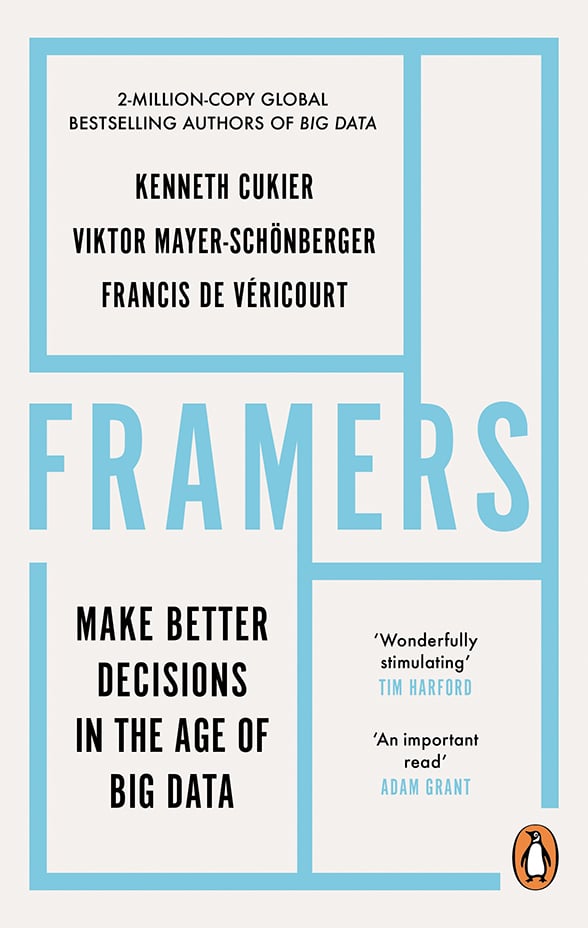
How we act depends on what we see. And what we see depends on how we frame it. In their book Framers, Viktor Mayer-Schönberger and his two co-authors explore how shifts in framing can have startling results.
Today Mayer-Schönberger is professor of internet governance and regulation at the Oxford Internet Institute. He was born in a "touristy" mountain village in Austria where his tax lawyer father bought an early computer for accounting.
"There were bets on how long the business would take to go bankrupt," Mayer-Schönberger remembers. "But it didn't. It flourished. And I became hooked on computers."
He started programming in his early teens and despite his clear preferences for physics and engineering, his father insisted that he studied law at Salzburg University. "So I started a software company, just to show that law was a bad use of my time," he says.
This was Ikarus Software, whose anti-virus products became bestsellers in Austria. Mayer-Schönberger nonetheless finished his law degree, following it up with a masters at Harvard Law School and another masters, this time in economics, at the London School of Economics.
In 1998 he became an assistant professor at the Harvard Kennedy School, the public policy school of Harvard University, where he taught for 10 years. By now he was developing an interest in internet governance.
Outstanding ideas
In 2009 he published Delete: The Virtue of Forgetting in the Digital Age. In it he argues that, in a digital age when information technology "remembers" everything, there is a need for the system, eventually, to forget.
His next book, co-written with Kenneth Cukier, a senior editor at The Economist was entitled Big Data: A Revolution That Will Transform How We Live, Work, and Think, proposed a new way of looking at data.
"For most of human history, we have collected very little data, because it's hard, and then we have squeezed it to get insights," Mayer-Schönberger says. "But it only worked if you had the right question."
Now that we have so much more data, however, it's possible to go on fishing expeditions. "All the data points are close, so you can look for patterns, which can create new questions."
Mental models
What Mayer-Schönberger and Cukier realised while they were writing Big Data was that, even if the data was robust, different people would use it to come to different decisions.
"Humans think in mental models all the time," Mayer-Schönberger points out. "Whatever the data, it's feeding into mental models which drive the options we see and the decisions we make." And computers don't develop their own mental models. They get them from humans.
For their next book, the pair decided they needed to bring in someone who knew about decision science and enlisted the help of Francis de Véricourt, professor of management science and director of the Centre for Decisions, Models and Data at Berlin's European School of Management and Technology. Together they produced Framers: Human Advantage in an Age of Technology and Turmoil.
The mental models that we choose and apply are frames, the book maintains. They determine how we understand and act in the world.
As an example, Mayer-Schönberger suggests you are in central London and need to get home. What are the options? Taxi? Underground? Bicycle? Shanks’s pony?
Then you imagine the possible consequences of each option. The cab is more comfortable but could get stuck in a jam. A bicycle might be quicker, but sweatier. And so on.
"You are comparing the decision options you have generated," he says. "The power is not in the comparison but in the generation."
You can use a frame to imagine a world that doesn't exist and what would happen if it did. Then, if it's a better version of reality, you can make it happen.
Questioning constraints
The authors cite the work of US psychologist Alison Gopnik, who believes very young children develop and use mental models in the same way as scientists perform experiments. When scientists do it, it's research. With toddlers, we call it ‘getting into everything’, Gopnik says.
"Children aren't honing their social skills," Mayer-Schönberger argues. "They are honing their framing skills. They imagine what would happen if they said or did that, then play it out. It's a power we possess from childhood, then forget to practice when we get older."
Sometimes we need to change our frames or invent new ones. Ingvar Kamprad did this in the 1950s when he started IKEA to sell flat-pack furniture. Until then, furniture was something expensive you bought for life and handed on to your children. Kamprad understood that it could be made cheaply and sold like clothing.
Mayer-Schönberger cautions that, in the world of investment, full-on reframing is very risky and often doesn't work. But frames are flexible and adjustable, and it can pay to look at the constraints you have been taking for granted. Spotify queried the constraint that music is something owned and controlled on our own devices, reimagining it as something streamed, remote and unlimited.
"Question the constraints of your model," Mayer-Schönberger advises. "As constraints evaporate, new decision options become available."


Ref: 25579 10013887




